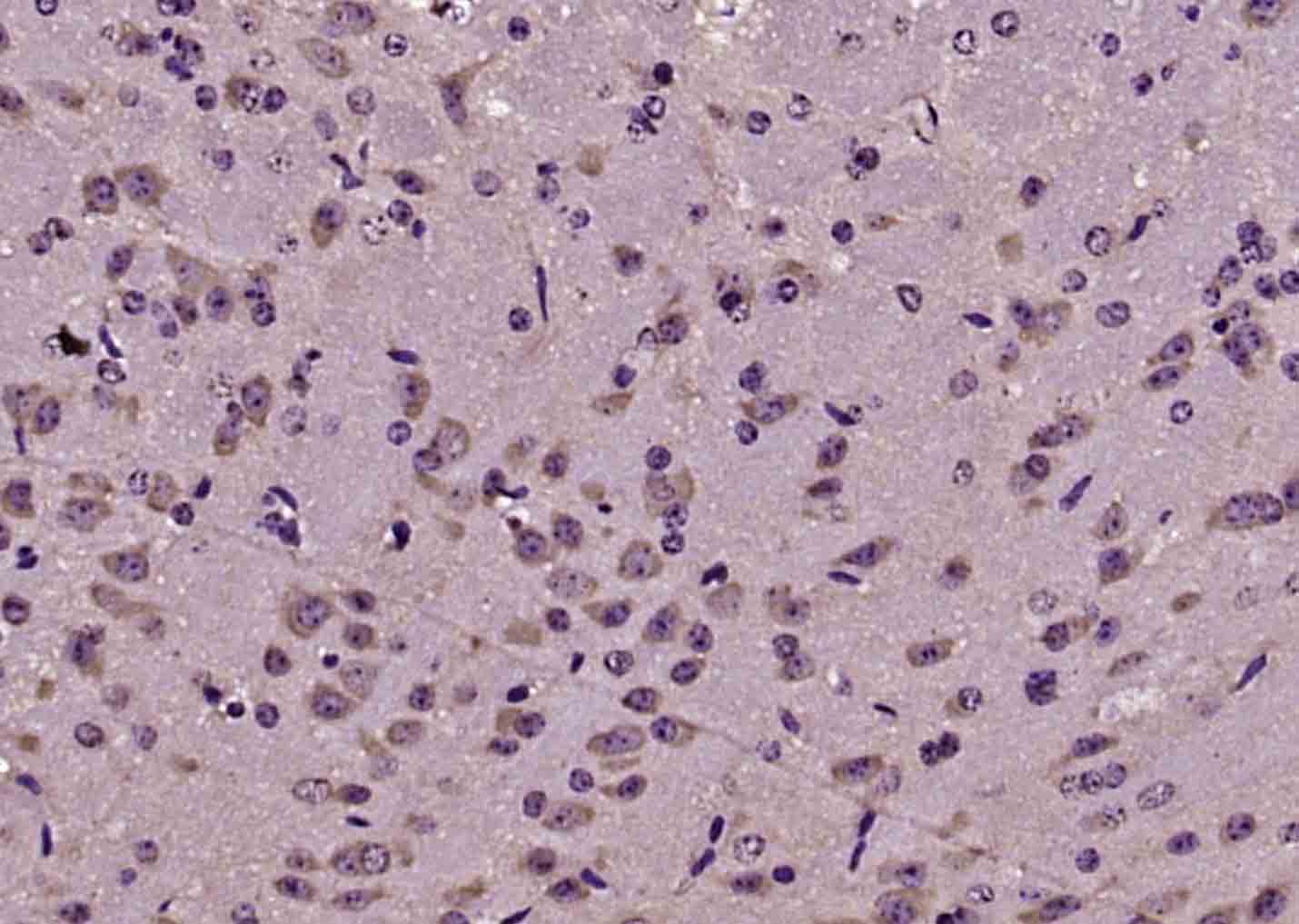
Rabbit Anti-CABP1 antibody
CABP 1; CABP1; CABP-1; CABP1_HUMAN; Calbrain; Calcium binding protein 1; Calcium binding protein 5; Calcium-binding protein 1; Caldendrin; HCALB BR; HCALB_BR.
View History [Clear]
Details
Product Name CABP1 Chinese Name 钙Binding protein1抗体 Alias CABP 1; CABP1; CABP-1; CABP1_HUMAN; Calbrain; Calcium binding protein 1; Calcium binding protein 5; Calcium-binding protein 1; Caldendrin; HCALB BR; HCALB_BR. Research Area Cell biology Neurobiology Signal transduction Binding protein Immunogen Species Rabbit Clonality Polyclonal React Species Mouse, (predicted: Human, Rat, Pig, Cow, Horse, Rabbit, Sheep, ) Applications ELISA=1:5000-10000 IHC-P=1:100-500 IHC-F=1:100-500 ICC=1:100-500 IF=1:100-500 (Paraffin sections need antigen repair)
not yet tested in other applications.
optimal dilutions/concentrations should be determined by the end user.Theoretical molecular weight 40kDa Cellular localization cytoplasmic The cell membrane Form Liquid Concentration 1mg/ml immunogen KLH conjugated synthetic peptide derived from human CABP1: 311-355/370 Lsotype IgG Purification affinity purified by Protein A Buffer Solution 0.01M TBS(pH7.4) with 1% BSA, 0.03% Proclin300 and 50% Glycerol. Storage Shipped at 4℃. Store at -20 °C for one year. Avoid repeated freeze/thaw cycles. Attention This product as supplied is intended for research use only, not for use in human, therapeutic or diagnostic applications. PubMed PubMed Product Detail Calcium plays an essential role in many biological processes. The calcium binding protein (CaBP) family shares much similarity to calmodulin. It has been shown that CaBP proteins can substitute functionally for, and probably augment the function of, calmodulin. Calcium binding proteins are a crucial part of calcium mediated cellular signal transduction in the central nervous system. There are several members of the family with varying expression patterns. CaBP1 and CaBP2 can be expressed as multiple, alternatively spliced variants in brain and retina. CaBP3, CaBP4 and CaBP 5 are restricted to retinal rod and cone cells. CaBP7 shares 70% homology with CaBP8 and 50% homology with CaM I.
Function:
Modulates calcium-dependent activity of inositol 1,4,5-triphosphate receptors (ITPRs). Inhibits agonist-induced intracellular calcium signaling. Enhances inactivation and does not support calcium-dependent facilitation of voltage-dependent P/Q-type calcium channels. Causes calcium-dependent facilitation and inhibits inactivation of L-type calcium channels by binding to the same sites as calmodulin in the C-terminal domain of CACNA1C, but resulting in an opposit effects on channel function. Suppresses the calcium-dependent inactivation of CACNA1D (By similarity). Inhibits TRPC5 channels. Prevents NMDA receptor-induced cellular degeneration.
Subunit:
Homodimer; when bound to calcium or magnesium. Interacts (via C-terminus) with ITPR1, ITPR2 and ITPR3. This binding is calcium dependent and the interaction correlates with calcium concentration. An additional calcium-independent interaction with the N-terminus of ITPR1 results in a decreased InsP(3) binding to the receptor. Interacts with CACNA1A (via C-terminal CDB motif) in the pre- and postsynaptic membranes. Interacts with CACNA1C (via C-terminal C and IQ motifs). The binding to the C motif is calcium independent whereas the binding to IQ requires the presence of calcium and is mutually exclusive with calmodulin binding. Interacts with CACNA1D (By similarity). Interacts with TRPC5 (via C-terminus). Interacts (via EF-hands 1 and 2) at microtubules with MAP1LC3B. Interacts with MYO1C and NELF
Subcellular Location:
Cytoplasm, cytoskeleton. Cytoplasm, perinuclear region. Cell membrane; Lipid-anchor; Cytoplasmic side. Golgi apparatus. Cell junction, synapse, postsynaptic cell membrane, postsynaptic density. Note=L-CaBP1 is associated most likely with the cytoskeletal structures, whereas S-CaBP1 is localized at or near the plasma membrane.
Tissue Specificity:
Retina and brain. Somatodendritic compartment of neurons. Calbrain was found exclusively in brain where it is abundant in the hippocampus, habenular area in the epithalamus and in the cerebellum.
Post-translational modifications:
Phosphorylated. The phosphorylation regulates the activity.
Similarity:
Contains 4 EF-hand domains.
SWISS:
Q9NZU7
Gene ID:
9478
Database links:Entrez Gene: 9478 Human
Entrez Gene: 29867 Mouse
Omim: 605563 Human
SwissProt: Q9NZU7 Human
SwissProt: Q9JLK7 Mouse
Unigene: 458482 Human
Unigene: 38551 Mouse
Product Picture
Bought notes(bought amounts latest0)
No one bought this product
User Comment(Total0User Comment Num)
- No comment



 +86 571 56623320
+86 571 56623320
 +86 18668110335
+86 18668110335

